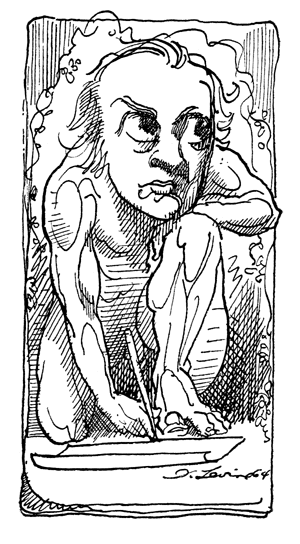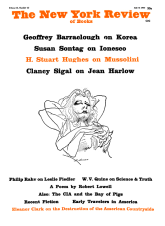The study of Blake’s sources is now a heavy industry, established in 1924 by S. Foster Damon and expanded by Northrop Frye, David V. Erdman, and others who have the academic capital to invest. In 1961 George Mills Harper explicated Blake’s platonism; in 1962 Kathleen Raine devoted her Mellon Lectures to Blake’s “enormous” knowledge of Plotinus, Porphyry, the Hermetica, alchemy, mystery religions, and classic myths; now Miss Hirst implies that reading Blake without knowing what he drew from Renaissance symbolism is like reading Joyce without knowing The Odyssey. Maybe. In any case we are fast getting on toward proving that Blake is a more traditional poet than Milton—which rather reverses things, and which may not stick.
With something of his accustomed ambiguity, T.S. Eliot wrote in 1920 that Blake betrays “a certain meanness of culture,” a philosophy like “an ingenious piece of home-made furniture.” Yet Eliot also remarked that Blake presents what is so essential that it needs no explanation: he “was naked, and saw man naked, and from the center of his own crystal.” I suspect Eliot has the right of it, as he often does, when he notes that Blake simply did not have the gift of knowing “how to borrow as Dante borrowed.” Because he did not know how to borrow, his poetry seems occult—to us; and recent efforts to give some context to the prophetic books, especially, have made interpretations of Blake’s iconology seem like deeply hermetic excursions.
Miss Hirst delves learnedly and easily into the “hidden riches” of Renaissance symbolism on which Blake drew, a kind of “Christian Cabalism” derived from Neoplatonism, the Corpus Hermeticum, the Zoharic and Lurianic Kabalah, and questions of tohu and bohu. Blake’s world, she says, “came into being in Ficino’s Florence, in the Italy of the High Renaissance,” and she has had the advantage of using researches by François Secret of the Sorbonne and Gersholm Scholem of the Hebrew University in retracing the course of this tradition which George Peele called
…the ancient reverend steps Of Trismegistus and Pythagoras, Through uncouth ways and unaccessible.
The tradition is partly alchemical, including Paracelsus’s principles of Salt, Sulphur, and Mercury, apparently the basis for Boehme’s dialectic, which was in turn rephrased by Hegel—and Blake. In The Marriage of Heaven and Hell Blake gives us the key to his own system: “Without Contraries is no progression. Attraction and Repulsion, Reason and Energy, Love and Hate, are necessary to Human existence.” That is why Blake saw divinity in man, who includes in himself the contraries that are, existentially, necessary to total humanity: “All deities reside in the human breast.” Or, as is always quoted, “Thou art a Man, God is no more.” This notion of the “human form divine” rephrases Swedenborg, who also affirmed that “God is very Man. In all the Heavens there is no other Idea of God, than that of a Man.” The idea is treacherous, for it is either in the grandest tradition of Renaissance humanism, or a denial of the Incarnation.
While Miss Hirst gives us a convenient epitome of the humanist tradition of man-as-the-measure, her singular contribution is her account of its degeneration through the seventeenth and eighteenth centuries into the phase of “enthusiasm,” from Boehme through the Philadelphians, William Law, and the increasing spiritual vulgarity of Robert Fludd, John Pordage, and Henry Brooke, to Mary Pratt and the “new Jerusalem” sects familiar to Blake. She has reported at length what is in the manuscripts of quietists who were more and more guided by their inner light. At the dead end of Blake’s exalted humanism is Rosicrucianism, and Miss Hirst, following the decline and fall of Neoplatonism into theosophy, is convinced that the Renaissance “contemplative philosophy” at last runs dry in gnosticism and magic.
She approves this esoteric humanism while it is “baptized,” but when the “tie with the Church was broken,” there was a lapse into what she calls “heresy.” Her closing pages, particularly, have some rather sanctimonious remarks on devotional Christology, the tenet of the Trinity, and Motherhood. Thus she detects in Blake “certain weaknesses, inherent from the start, in the traditional symbolism he used.” However, she insists that Blake remained Christian (Kathleen Raine would agree).
Indeed, it is hard to speak of this book without using the language of theology, for the “hidden riches” in Blake’s thought prove, finally, to be heresies one or another way associated with a Neoplatonism that is a veiled gnosticism, a belief in the consubstantiality of matter and spirit. Miss Hirst is loath to draw this conclusion from her own evidence, and with a certain malaise she suggests that in spite of heretical elements in his thought, Blake conforms, somehow undamaged by the perversion of Christian Cabalism to enthusiasm. The perversion, she finds, was due to Montanism, a heresy perhaps best described by Eusebius in his Church History: one Montanus the Phrygian became “possessed of a spirit, and suddenly began to rave in a kind of ecstatic trance, and to babble in a jargon, prophesying in a manner contrary to the custom of the Church,” and believing himself inspired by the Holy Ghost. The evangelicals were so possessed, Mary Pratt writing how “the Lord instructed me in revelation…because I am the first, who ever had the honour to have the seventh seal opened to them.”
Advertisement
Such enthusiasm does derive from Renaissance Neoplatonism, a humanism at its highest pitch, an open secret that was a brave attempt to synthesize Christian doctrine with the gnostic elements in the cabala and the classics. In Renaissance philosophy and art the “exempada” was central—the theory of proportion illustrated by the image of man, arms and legs extended, as symbol of a divine harmony in the cosmos. Pico della Mirandola supposed he could reconcile Mosaic and Greek with Christian mysteries in a humanism that was anything but parochial. During her latter chapters, however, Miss Hirst takes a decisively parochial view of the syncretism that is not “baptized.” She understands that the Renaissance philosophy behind Blake is catholic, but she rejects it when it ceases to be Catholic, when it loses “firm hold on basic Christian truth.” Beyond question Neoplatonism was corrupted into theosophy and occultism, yet Miss Hirst rightly concludes that Blake was no mere occultist. Neither was he Christian in Miss Hirst’s sense of the term.
The truth is that Blake had the same thirst for divinity as other romantics, notably Shelley, whose Prometheus is a man-god like Blake’s Albion—a romantic exempada, in fact. If “Forgiveness of Sins” is Christian, Blake was Christian; but he was unorthodox about the Incarnation. Romantically enough, Blake believed that man can become divine—is, at his most human, God. That is to say, Blake belongs to the history of Euhemerism, and we know from Jean Seznec’s Survival of the Pagan Gods how Euhemeristic themes reached into and beyond the Renaissance. Blake is at one with Ludwig Feuerbach, whose Essence of Christianity proposed that “Man has his highest being, his God, in himself.” Even Miss Hirst notes how Blake rejected the notion of Atonement: “it is a horrible doctrine. If another man pay your debt, I do not forgive it.” Monumentally her evidence associates Blake with a cabalistic humanism that was “very close to the original syncretism of the Italian academies” and to Cornelius Agrippa’s “classic presentation of the conception of Man as the Measure of the Universe”—in short, “the human form divine.”
Together with Christian Cabalists Blake affirmed that “All religions are one” and “have one source”: “The true Man is the source, he being the Poetic Genius.” Miss Hirst’s trouble is her unwillingness to accept syncretism whereever there was “too great an influence from the Jewish and Greek elements.” Blake was as unorthodox as the great tradition he received—unorthodox in the narrow sense, also, that he was fiercely and constantly anti-institutional. Like Kierkegaard, he saw the priest as nonsense in long clothes. His scathing parody of the Lord’s Prayer links him with eighteenth-century Voltairean modes of thought: “Lawful Bread, Bought with Lawful Money, & a Lawful Heaven, seen thro’ a Lawful Telescope, by means of Lawful Window Light! The Holy Ghost, & whatever cannot be Taxed, is Unlawful & Witchcraft. Spirits are Lawful, but not Ghosts.” For, he concludes, “God is only an Allegory of Kings & nothing Else.” Ecrasez l’infame. Or, as Miss Hirst says, “He stands a rebel.” Then she adds “But he stands a Christian.” Perhaps. It depends.
It is natural that Miss Hirst should depreciate whatever in Blake belonged to the Enlightenment, a manifestation for which she has nothing but distrust. Yet Blake was a child of the Enlightenment, too, as David Erdman indicates by the very title of his own book on Blake, Prophet Against Empire. Miss Hirst forgets that Voltaire had his own brand of humanism, and she sees the eighteenth century, apart from the evangelicals, as an age “given over entirely to rationalism and materialism,” with “an outlook in many ways far more superficial and cynical than the one which preceded it.” Accordingly she dislikes Thomas Taylor’s variety of Platonism, and to find what Blake owed to Tom Taylor, we must read Kathleen Raine and George Harper, not Miss Hirst. It is just this enlightened side of Blake that saved him from Swedenborgian extremes. (Miss Hirst remarks that “the more reputable mediaeval theologians” like Aquinas or Duns Scotus “would have made short work” of Swedenborg’s “mental confusion.”)
As for rationality, Blake’s cabalism was steeped in a “cosmic geometry” at once mathematical and symbolic. Pythagorean theories of number, harmony, and proportion were symbolized by an archetypal figure in the Neoplatonic, gnostic, cabalistic tradition—the tetractis as conceived by Vitruvius, Cornelius Aprippa, and Dürer. “The Pythagoreans,” wrote Agrippa, “call the Number four Tetractis, and prefer it before all the vertues of Numbers, because it is the foundation and root of all other numbers; whence also all foundations, as well in artificial things as naturally, and divine, are foursquare.” The Zoas are four-square.
Advertisement
If, then, we can tolerate Miss Hirst’s theology and her prejudice against the Enlightenment, we have here some new chapters in the history of ideas giving a coherent, full account of how a humanist- hermetic philosophy collapsed through Philadelphian levels into an inner- light evangelism that made “the new Jerusalem gentlemen” look so silly (Christopher Walton on Henry Brooke: “poor, simple Harry”). But we must always remember that the mystique of Renaissance humanism was an “open” hermeticism, ecumenical, learned, balanced, and truly classic in proportion, symbolizing a certain precarious integrity in western culture. Then it fissured into more and more exclusive sectarian groups—among which we are tempted to place Miss Hirst’s very orthodox Christianity as one.
By contrast we can appraise Blake’s unorthodoxy by saying that in spite of his awkwardness in borrowing, he belongs in spirit to the syncretic wisdom of his great tradition. Neither Behmenists, Swedenborgians, nor freakish English dissenters injure his piety, and his vision of his own new Jerusalem is not parochial, but an idea of man as potentially God. It is truer of Blake than of Shelley that he created his most daring visions from the wreck of hopes. Blake could not have had these visions without his gnostic heritage, and his poetic apparatus does not always conceal his catholic humanism.
This Issue
July 9, 1964




